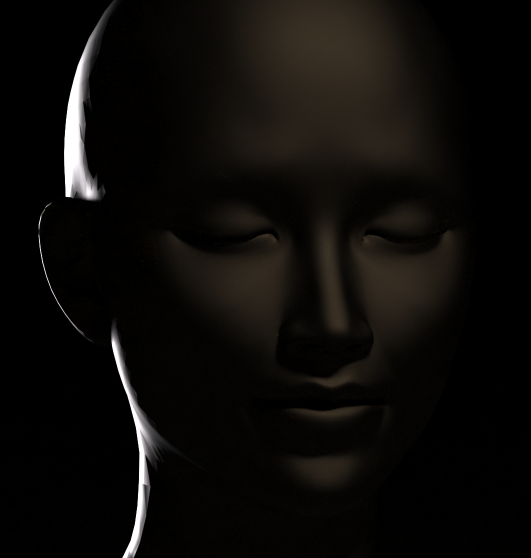Remember that the paper's using a very different rendering method. In theory everything should work the same (just mlt will be a lot slower), but there will be some differences in look due to the way the materials are set up.
ryjo, it might be a better idea to use a 3-point lighting setup with a hot rim to more clearly see the effect. subsurface scattering at a realistic scale for human skin tends to a soft diffuse under ibl in a lot of cases. are you using the correct scale for your head? maybe you should try tests at half and quarter scale to pronounce the effect more.
Moreover, by far the most important thing in skin rendering (much more important than subsurface scattering) is having a good colour map to begin with.
Skin test
Thanks for your suggestions. I'll look into it. I tried a version with a light behind the head to get a "light throught ear" effect, but it doesn't show up. here is the result:playmesumch00ns wrote:Remember that the paper's using a very different rendering method. In theory everything should work the same (just mlt will be a lot slower), but there will be some differences in look due to the way the materials are set up.
ryjo, it might be a better idea to use a 3-point lighting setup with a hot rim to more clearly see the effect. subsurface scattering at a realistic scale for human skin tends to a soft diffuse under ibl in a lot of cases. are you using the correct scale for your head? maybe you should try tests at half and quarter scale to pronounce the effect more.
Moreover, by far the most important thing in skin rendering (much more important than subsurface scattering) is having a good colour map to begin with.

This uses a meshlight behind the model, and an area light in front (low power). Linear tonemapping was used fpr this.
Ryjo:
There is definitely something wrong going on there.
There should be light visibly scattered through the ear.
1) check your model size. Look at log.txt and check the AABB size for the head mesh(es). Should be ~= 0.2m high.
(however, note that this scale will be modified by the scale attribute in the <model> XML element)
2) Check distance between the two meshes (skin layers). Should be ~= 0.00025m
3) Try using specular material at both skin interfaces for now.
It may look ugly, but at least any potential energy loss problem with glossy_transparent will be avoided.
There is definitely something wrong going on there.
There should be light visibly scattered through the ear.
1) check your model size. Look at log.txt and check the AABB size for the head mesh(es). Should be ~= 0.2m high.
(however, note that this scale will be modified by the scale attribute in the <model> XML element)
2) Check distance between the two meshes (skin layers). Should be ~= 0.00025m
3) Try using specular material at both skin interfaces for now.
It may look ugly, but at least any potential energy loss problem with glossy_transparent will be avoided.
-
playmesumch00ns
- Posts: 21
- Joined: Wed Jun 28, 2006 11:44 pm
I was talking about the way you handle light transmission at the air/skin interface more than the scattering behaviour once light has entered the skinOnoSendai wrote:The paper uses an approximation to unbiased SSS, but the approximation is reasonably accurate, so the rendering methods are actually very similar.
@OnoSendai: The model approx 0.1 units high (from AABB), I scale this in the model element by 2.8, so it becomes 0.28m, from the lower neck to top of head. The epi thickness is pre-divided by 2.8, so the scaling should make it correct.
Thanks all for comments and input. I'll try the suggestions and see if it helps!
Thanks all for comments and input. I'll try the suggestions and see if it helps!
Who is online
Users browsing this forum: No registered users and 3 guests


